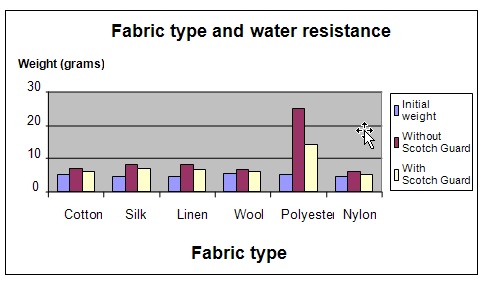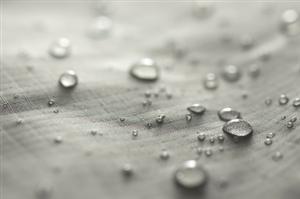| Complexity level: | 7 |
| Project cost ($): | 30 |
| Time required: | 1 hour to prepare, 2 hours for science fair project |
| Material availability: | Easily found at a department store |
| Safety concerns: | Basic safety requirements |
Hypothesis
Our first hypothesis is that amongst the fabric types, polyester will be the most water resistant. Our second hypothesis is that all fabrics demonstrate better water resistance after a layer of Scotch Guard is applied.
Overview
Fabric types and water resistance
Fabrics are materials that are used to make clothing, cushion covers, curtains and table cloth, amongst others. Many types of fabric and available on the market, and they are made from many different types of materials, textures and colors. The fabrics can be made from natural or synthetic materials.
Cotton is the most common type of fabric used for making clothing. It is durable, cheap and easy to clean but tends to shrink at high temperatures. Silk is made from the cocoon of the silkworm. It is a soft and shiny fabric but very expensive. Wool is made from animal hair that is knitted very tightly and is suitable for winter use because it is very effective in keeping us warm during winter, whilst absorbing moisture and resisting static. Linen is made from vegetable fibers and with cotton, it is the preferred choice for manufacturing summer clothing because it is light and comfortable. Synthetic fabrics like polyester or nylon are cheaper, stretchable and easier to clean.
Waterproof fabrics prevent water droplets from being absorbed but allow water vapor to pass through them. They are made by closely knitting the fibers or providing them with a coating of waterproof material.
Scientific Terms
Materials
The materials required for this science fair project:
- 1 ramp elevated at 45 degrees
- 2 pieces of cotton cloth
- 2 pieces of silk cloth
- 2 pieces of linen cloth
- 2 pieces of wool cloth
- 2 pieces of polyester cloth
- 2 pieces of nylon cloth
- 1 roll of Scotch tape
- 1 pair of scissors
- 1 ruler
- tap water
- 1 measuring cylinder
- 1 plastic bottle with holes on the cover (a self-deviced water sprinkler)
- 1 digital weighing scale
Procedure
1. For this science fair project, the independent variable is the use of Scotch Guard and the type of fabric tested - cotton, silk, linen, wool, polyester and nylon . The dependent variable is the amount of water absorbed by the fabric. This is determined by measuring the weight of the fabric before and after wetting the fabric. The constants (control variables) are the size of the fabric, the elevation of the ramp and the amount of water dispensed.
2. The twelve pieces of cloth are cut into the same size and their weight is checked on the digital weighing scale. Two pieces of fabric of the same type should have the same weight. If not, trim the edges of the heavier piece very slightly and re-weigh to see if they are now of the same weight. Repeat the process until they are. The measured weight is recorded in the table given below.
3. One piece of cloth from each type of fabric is treated with Scotch Guard.
4. The first piece of fabric to be tested is spread on the ramp. The sides of the fabric are taped with scotch tape to prevent water from entering the sides. 300ml of water is measured and poured into the plastic bottle and the cover screwed on. All of the water from the bottle is then sprinkled over the cloth and it is left on the ramp for 5 minutes for the excess water to flow ff.
5. The fabric is removed from the ramp and its weight is recorded in the table below.
6. Procedures 4 and 5 are repeated using the fabric that was treated with Scotch Guard.
7. Procedures 4, 5 and 6 are repeated using the remaining 5 types of fabrics and their weights are recorded in the table given below.

Results
The results showed that nylon and wool were the most water resistant fabrics and polyester was the least. Treating fabrics with Scotch Guard made them more waterproof.
|
Condition |
Fabric water resistance with and without Scotch Guard (grams) |
|||||
|
Cotton |
Silk |
Linen |
Wool |
Polyester |
Nylon |
|
|
Initial weight |
5.1 |
4.5 |
4.7 |
5.8 |
4.9 |
4.7 |
|
Without Scotch Guard |
6.9 |
8.1 |
7.9 |
6.7 |
24.7 |
5.9 |
|
With Scotch Guard |
6.1 |
7.1 |
6.8 |
6.3 |
14.3 |
5.3 |
The chart below represents the results of our experiment.

Conclusion
Our first hypothesis - that amongst the fabric types, polyester is the most water resistant – has been proven to be false. Our second hypothesis - that all fabrics demonstrate better water resistance after a layer of Scotch Guard is applied – has been prove correct.
Waterproof fabrics can be made from natural or synthetic materials. Their ability to resist water droplets makes them suitable for use in manufacturing raincoats, tents and swimming attire . They are normally given a coating of waterproofing chemicals like PVC, rubber or wax.
Also consider
The science fair project can also be repeated using different types of fabrics besides the ones that we tested.
Try to repeat the science project experiment by immersing the fabric in water and comparing the time taken for them to dry.
References
What are different types of dressmaking fabric? - http://www.wisegeek.com/what-are-the-different-types-of-dressmaking-fabric.htm
Waterproof fabric - http://en.wikipedia.org/wiki/Waterproof_fabric
How does Scotch Guard work? - http://www.articlesbase.com/home-improvement-articles/how-does-scotch-guard-work-851556.html

